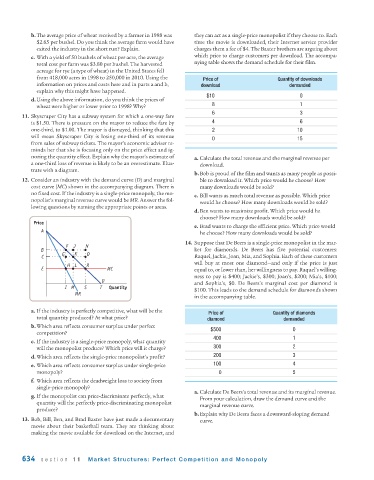Page 676 - Krugmans Economics for AP Text Book_Neat
P. 676
b.The average price of wheat received by a farmer in 1998 was they can act as a single-price monopolist if they choose to. Each
$2.65 per bushel. Do you think the average farm would have time the movie is downloaded, their Internet service provider
exited the industry in the short run? Explain. charges them a fee of $4. The Baxter brothers are arguing about
c. With a yield of 50 bushels of wheat per acre, the average which price to charge customers per download. The accompa-
total cost per farm was $3.80 per bushel. The harvested nying table shows the demand schedule for their film.
acreage for rye (a type of wheat) in the United States fell
from 418,000 acres in 1998 to 250,000 in 2010. Using the Price of Quantity of downloads
information on prices and costs here and in parts a and b, download demanded
explain why this might have happened.
$10 0
d.Using the above information, do you think the prices of
wheat were higher or lower prior to 1998? Why? 8 1
6 3
11. Skyscraper City has a subway system for which a one-way fare
is $1.50. There is pressure on the mayor to reduce the fare by 4 6
one-third, to $1.00. The mayor is dismayed, thinking that this 2 10
will mean Skyscraper City is losing one-third of its revenue
0 15
from sales of subway tickets. The mayor’s economic adviser re-
minds her that she is focusing only on the price effect and ig-
noring the quantity effect. Explain why the mayor’s estimate of a. Calculate the total revenue and the marginal revenue per
a one-third loss of revenue is likely to be an overestimate. Illus- download.
trate with a diagram.
b.Bob is proud of the film and wants as many people as possi-
12. Consider an industry with the demand curve (D) and marginal ble to download it. Which price would he choose? How
cost curve (MC) shown in the accompanying diagram. There is many downloads would be sold?
no fixed cost. If the industry is a single-price monopoly, the mo-
c. Bill wants as much total revenue as possible. Which price
nopolist’s marginal revenue curve would be MR. Answer the fol-
would he choose? How many downloads would be sold?
lowing questions by naming the appropriate points or areas.
d.Ben wants to maximize profit. Which price would he
choose? How many downloads would be sold?
Price
e. Brad wants to charge the efficient price. Which price would
A
he choose? How many downloads would be sold?
14. Suppose that De Beers is a single-price monopolist in the mar-
F J N
B ket for diamonds. De Beers has five potential customers:
G K O
C Raquel, Jackie, Joan, Mia, and Sophia. Each of these customers
will buy at most one diamond—and only if the price is just
H L R
E MC equal to, or lower than, her willingness to pay. Raquel’s willing-
ness to pay is $400; Jackie’s, $300; Joan’s, $200; Mia’s, $100;
D
and Sophia’s, $0. De Beers’s marginal cost per diamond is
I M S T Quantity $100. This leads to the demand schedule for diamonds shown
MR
in the accompanying table.
a. If the industry is perfectly competitive, what will be the Price of Quantity of diamonds
total quantity produced? At what price? diamond demanded
b.Which area reflects consumer surplus under perfect
$500 0
competition?
400 1
c. If the industry is a single-price monopoly, what quantity
will the monopolist produce? Which price will it charge? 300 2
d.Which area reflects the single-price monopolist’s profit? 200 3
e. Which area reflects consumer surplus under single-price 100 4
monopoly? 0 5
f. Which area reflects the deadweight loss to society from
single-price monopoly?
a. Calculate De Beers’s total revenue and its marginal revenue.
g. If the monopolist can price-discriminate perfectly, what
From your calculation, draw the demand curve and the
quantity will the perfectly price-discriminating monopolist
marginal revenue curve.
produce?
b.Explain why De Beers faces a downward-sloping demand
13. Bob, Bill, Ben, and Brad Baxter have just made a documentary curve.
movie about their basketball team. They are thinking about
making the movie available for download on the Internet, and
634 section 11 Market Structures: Perfect Competition and Monopoly

